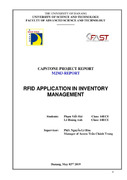
Please use this identifier to cite or link to this item:
http://thuvienso.dut.udn.vn/handle/DUT/5549| Title: | Rfid application in inventory management | Authors: | Lê, Hoàng Anh Phạm, Viết Hải |
Advisor: | TS. Nguyễn, Lê Hòa Trần, Chánh Trung |
Keywords: | Rfid application;Inventory management | Issue Date: | 2019 | Publisher: | Trường Đại học Bách khoa - Đại học Đà Nẵng | Abstract: | Inventory management is the backbone for almost all the companies in the modern industrial world. Inventory management is very much essential to define the growth, subsistence or the success of any companies. Poor inventory management can lead to sales diminution, loss of revenue which in turn can result in the lack of success of a business. Unfortunately not all the business seem to have proper inventory management in place. Business enterprises face problems like product misplacement, reproduced products, and replacement of stock on shelves. Stock outs are estimated at 30% which affects retail sales by 5% to 18% (Xin 2009). The application of RFID has shown to be the top available advanced technology in improving inventory management for most enterprises like WalMart stores. RFID technology helps the reading of products in real time and eliminates problems like reproduced, replacement of stock, and product misplacement without requiring human interference. The information is sent immediately and directly to the back-end system for immediate or later retrieval for taking proper decision to the inventory manager. The use of radio wave technology has developed into a relatively new application called Radio Frequency Identification (RFID). RFID technology consists of two basic hardware components, a reader and a tag. A typical RFID tag is a non powered microchip with an antenna that broadcasts encoded information. The tag transmissions are carried out over RF waves that are activated when placed in the transmission field of a reader. The data embedded in a tag can provide a wealth of information about an item and its current status. Two common uses of RFID technology are to show about a product or good location (manufacturing, inventory, in-transit) and product identification (price, serial number, store ID, antitheft protection). This system could allow accurate tracking of a product from the manufacturing process to a retail store shelf . These information bearing tags are called smart tags or smart labels. Effective inventory management depends upon consolidating, integrating, and analyzing data collected from many sources such as, distribution center and inventory. Traditional inventory tracking systems require manual intervention, which is labour intensive, time consuming, and error-prone. |
Description: | 59 Tr. |
URI: | http://thuvienso.dut.udn.vn/handle/DUT/5549 |
| Appears in Collections: | Khoa Khoa học Công nghệ tiên tiến - Điện tử Viễn thông |
Files in This Item:
| File | Description | Size | Format | Existing users please Login |
|---|---|---|---|---|
| 2.DA.FA.19.009.Le Hoang Anh.pdf | Thuyết minh | 12.68 MB | Adobe PDF |  |
CORE Recommender
Page view(s) 50
26
checked on Nov 14, 2025
Download(s) 50
3
checked on Nov 14, 2025
Google ScholarTM
Check
Items in DSpace are protected by copyright, with all rights reserved, unless otherwise indicated.